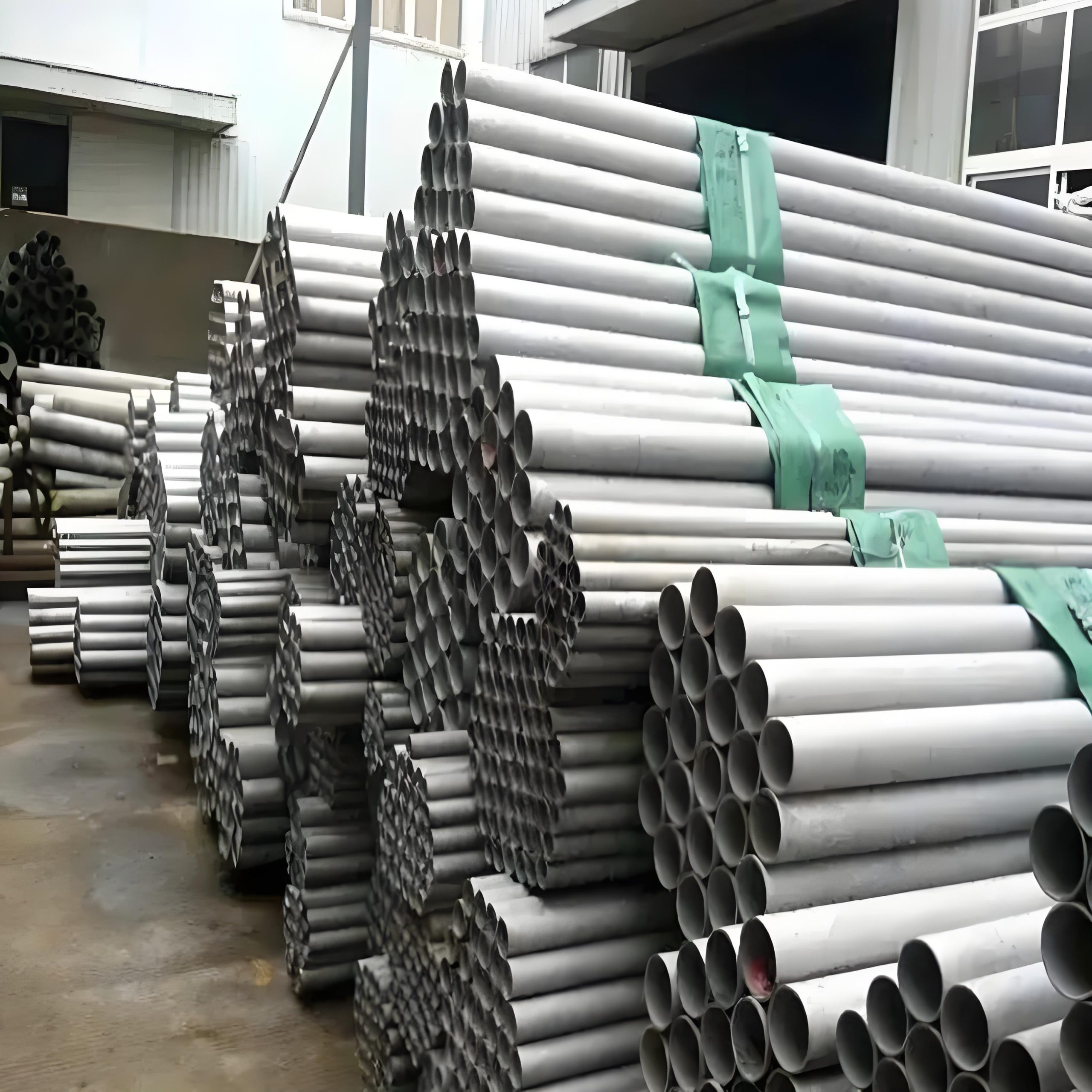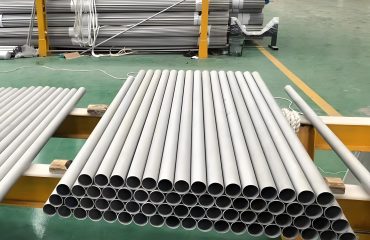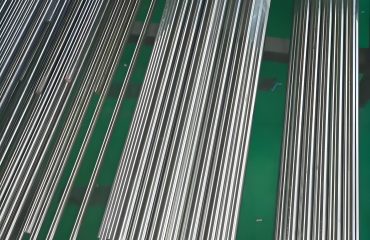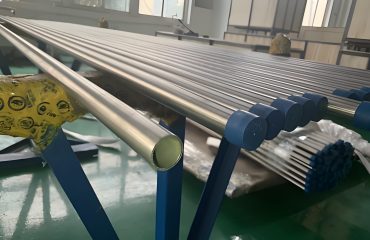
1. Chemical Processing Industry
The chemical processing industry is the largest consumer of Hastelloy C-22 pipes due to their ability to withstand aggressive chemicals, including strong acids, bases, and halogens.
1.1 Acid Handling Systems
Hastelloy C-22 pipes are extensively used in systems handling:
-
Nitric Acid: C-22’s high chromium content (20.0–22.5%) provides superior resistance to oxidizing acids. For example, in nitric acid production plants, C-22 pipes are used in reactors and piping systems operating at 60–90°C, where corrosion rates are less than 0.01 mm/year compared to 1.5 mm/year for stainless steel 316L.
-
Hydrochloric Acid: While slightly less resistant than C-276 in strong reducing acids, C-22 performs well in dilute hydrochloric acid (up to 10%) and mixed acid systems containing chlorides.
-
Sulfuric Acid: C-22 pipes are used in sulfuric acid processing at concentrations up to 50%, maintaining structural integrity at elevated temperatures.
Example: In a fertilizer plant producing phosphoric acid, C-22 pipes transport acid slurries containing chlorides and fluorides. Their resistance to pitting (PREN = 47) ensures a service life exceeding 10 years, compared to 2–3 years for Alloy 825.
1.2 Chlorine and Chlorinated Compounds
C-22 pipes excel in environments involving wet chlorine gas, hypochlorite solutions, and chlorinated organic compounds. Their resistance to pitting and crevice corrosion makes them ideal for:
-
Piping in chlor-alkali plants producing chlorine and caustic soda.
-
Heat exchangers handling chlorinated solvents in chemical synthesis.
Case Study: A chlor-alkali facility replaced stainless steel pipes with C-22 pipes in a wet chlorine gas transport line. The C-22 pipes exhibited no measurable corrosion after 5 years, while stainless steel failed within 18 months due to pitting.
1.3 Reactor and Column Piping
In chemical reactors and distillation columns, C-22 pipes transport corrosive intermediates and byproducts. Their weldability and resistance to intergranular corrosion ensure reliability in as-welded systems.
Comparison: Compared to Hastelloy C-276, C-22 is preferred in reactors exposed to oxidizing media (e.g., nitric acid vapors), while C-276 is favored for reducing acids like hydrochloric acid.
2. Pharmaceutical Industry
The pharmaceutical industry relies on Hastelloy C-22 pipes for processes involving corrosive intermediates, sterile environments, and high-purity requirements.
2.1 Active Pharmaceutical Ingredient (API) Synthesis
During API synthesis, C-22 pipes handle:
-
Corrosive reagents like acetic acid, hydrobromic acid, and chlorinated solvents.
-
High-purity fluids requiring non-contaminating materials.
Example: In the production of oncology drugs, C-22 pipes transport brominated intermediates at 50°C. Their low iron content (2.0–6.0%) minimizes contamination, ensuring compliance with FDA purity standards.
2.2 Clean-in-Place (CIP) Systems
C-22 pipes are used in CIP systems exposed to aggressive cleaning agents like sodium hypochlorite and phosphoric acid. Their smooth, pickled surfaces resist biofilm formation, maintaining sterility.
Advantage: Unlike stainless steel 304, which corrodes in hypochlorite solutions, C-22 maintains integrity, reducing maintenance costs.
3. Pollution Control and Environmental Protection
Hastelloy C-22 pipes are critical in pollution control systems handling corrosive gases, liquids, and slurries.
3.1 Flue Gas Desulfurization (FGD) Systems
In coal-fired power plants, FGD systems use C-22 pipes to transport acidic slurries containing sulfur dioxide and chlorides. The alloy’s resistance to pitting and crevice corrosion ensures reliability in wet, chloride-rich environments.
Example: An FGD scrubber using C-22 pipes reported a corrosion rate of <0.02 mm/year in a 10% sulfuric acid slurry at 60°C, compared to 0.5 mm/year for duplex stainless steel.
3.2 Stack Liners and Ducting
C-22 pipes and fittings are used in stack liners exposed to acidic condensates. Their ability to withstand mixed acid environments (sulfuric and hydrochloric) extends service life.
Comparison: C-22 outperforms C-276 in FGD systems due to its higher chromium content, which enhances resistance to oxidizing acid condensates.
4. Nuclear Power Industry
The nuclear industry uses Hastelloy C-22 pipes for their corrosion resistance and reliability in radioactive and corrosive environments.
4.1 Radioactive Waste Handling
C-22 pipes transport corrosive radioactive waste streams containing nitric acid and chlorides. Their low corrosion rates ensure containment integrity.
Example: In a nuclear waste reprocessing facility, C-22 pipes handling 8M nitric acid at 80°C exhibited corrosion rates of <0.01 mm/year, meeting stringent safety requirements.
4.2 Cooling Systems
In nuclear reactors, C-22 pipes are used in cooling systems exposed to seawater or chloride-containing coolants. Their pitting resistance (PREN = 47) prevents leaks in critical systems.
Advantage: Compared to titanium, C-22 offers better resistance to mixed acid environments, making it suitable for hybrid cooling systems.
5. Pulp and Paper Industry
The pulp and paper industry uses Hastelloy C-22 pipes in processes involving corrosive liquors and bleaching agents.
5.1 Digesters
C-22 pipes transport alkaline and acidic liquors in kraft pulping digesters. Their resistance to stress corrosion cracking in high-temperature alkaline environments ensures reliability.
Example: A pulp mill replaced stainless steel 316L pipes with C-22 in a digester line handling sodium hydroxide at 150°C. The C-22 pipes showed no cracking after 5 years, while 316L failed within 2 years.
5.2 Bleach Plants
In chlorine dioxide and hypochlorite bleaching stages, C-22 pipes resist corrosion from oxidizing agents, extending maintenance intervals.
Comparison: C-22’s superior performance in oxidizing bleach solutions makes it preferable to C-276, which is better suited for reducing environments.
6. Marine and Offshore Engineering
Hastelloy C-22 pipes are used in marine environments due to their exceptional resistance to seawater and chloride-induced corrosion.
6.1 Seawater Piping
In desalination plants and offshore platforms, C-22 pipes transport seawater for cooling or processing. Their high PREN ensures resistance to pitting and crevice corrosion.
Example: An offshore oil platform used C-22 pipes in a seawater cooling system, achieving a 15-year service life without pitting, compared to 5 years for copper-nickel alloys.
6.2 Sour Gas Environments
In offshore oil and gas wells, C-22 pipes handle sour gas (H₂S) and chloride-rich fluids, resisting stress corrosion cracking and pitting.
Advantage: Compared to Monel 400, C-22 offers better resistance to sour gas environments, reducing the risk of catastrophic failures.
7. Oil and Gas Industry
The oil and gas industry uses C-22 pipes in upstream and downstream operations involving corrosive fluids.
7.1 Upstream Applications
In sour gas wells, C-22 pipes transport fluids containing hydrogen sulfide, carbon dioxide, and chlorides. Their resistance to sulfide stress cracking meets NACE MR0175/ISO 15156 standards.
Example: A deepwater well used C-22 pipes for gas injection lines, achieving zero corrosion-related failures over 10 years.
7.2 Downstream Applications
In refineries, C-22 pipes handle acidic crude oils and corrosive byproducts in hydroprocessing units.
Comparison: C-22 outperforms Alloy 825 in high-chloride refinery streams, extending maintenance intervals.
8. Waste Treatment and Incineration
Hastelloy C-22 pipes are used in waste treatment facilities handling corrosive waste streams.
8.1 Hazardous Waste Incineration
In incinerators, C-22 pipes transport acidic gases and condensates containing hydrochloric and sulfuric acids. Their resistance to mixed acid environments ensures durability.
Example: A hazardous waste incinerator used C-22 pipes in a scrubber system, achieving a corrosion rate of <0.015 mm/year in a 20% HCl environment.
8.2 Wastewater Treatment
In industrial wastewater treatment, C-22 pipes handle corrosive effluents containing chlorides and organic acids.
Advantage: Compared to PVC or coated carbon steel, C-22 offers superior durability in high-temperature, corrosive wastewater streams.
9. Aerospace and High-Temperature Applications
While less common, C-22 pipes are used in aerospace applications requiring corrosion resistance at moderate temperatures.
9.1 Fuel and Exhaust Systems
In aerospace fuel systems, C-22 pipes handle corrosive fuels and exhaust gases, resisting oxidation and pitting.
Comparison: Compared to Inconel 625, which is preferred for high-temperature strength, C-22 is chosen for corrosion-critical components.
10. Emerging Applications
10.1 Renewable Energy
In geothermal and solar thermal plants, C-22 pipes transport corrosive brines and heat transfer fluids. Their resistance to chloride-induced corrosion ensures reliability in high-salinity environments.
10.2 Hydrogen Production
In green hydrogen production, C-22 pipes handle acidic electrolytes in electrolyzers, resisting corrosion from sulfuric acid and chlorides.
Example: A pilot hydrogen plant used C-22 pipes in an electrolyzer, achieving a 10-year service life without maintenance.
Scientific Analysis of Application Suitability
10.1 Corrosion Resistance in Context
Hastelloy C-22’s high PREN (47) and balanced composition make it ideal for applications involving:
-
Oxidizing Acids: Superior to C-276 in nitric acid and mixed acid systems.
-
Chloride Environments: Comparable to C-276 but with better weldability due to lower iron content.
-
Mixed Environments: Outperforms Inconel 625 and Alloy 825 in systems with both oxidizing and reducing media.
Data: In ASTM G48 pitting tests, C-22 exhibits a critical pitting temperature (CPT) of 80°C in 6% FeCl₃, compared to 75°C for C-276 and 60°C for Inconel 625.
10.2 Mechanical Performance
C-22’s mechanical properties (tensile strength: 690 MPa, elongation: 45%) ensure reliability in high-pressure piping systems, such as those in chemical reactors and offshore platforms.
Comparison: While Inconel 625 offers higher strength (830 MPa), C-22’s greater ductility makes it easier to fabricate into complex piping systems.
10.3 Cost-Benefit Analysis
C-22’s higher cost ($45–$65/kg) is justified by its extended service life in oxidizing environments. For example, in a nitric acid plant, C-22 pipes last 20% longer than C-276, reducing lifecycle costs.




You must be logged in to post a comment.